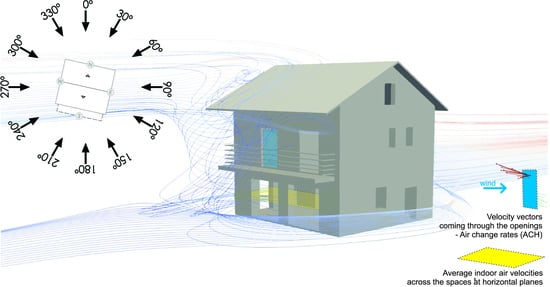Using CFD to Evaluate Natural Ventilation through a 3D Parametric Modeling Approach
Abstract
1. Introduction
1.1. State of the Art in Wind-Driven Natural Ventilation Investigations
1.2. Assessing Natural Ventilation in CFD
2. Methodology
2.1. Overview
2.2. Reference Building and Wind Velocities Measurements
2.3. Wind Data Input for CFD Simulations
3. CFD Model
3.1. Model Configuration
3.1.1. Domain
3.1.2. Solver Settings
3.1.3. Mesh Processing and Boundary Conditions
3.2. Model Verification
4. Post-Processing
4.1. Air Velocities
4.2. ACH—Integration Method (All Velocity Vectors)
4.3. ACH—Integration Method (Without Recirculation)
5. Results and Discussions
5.1. CFD 1—Measurement Week
5.2. CFD 2—Cooling Season
- Air velocities
- ACH—Integration Method
6. Research Constraints and Remarks
- Assessment of natural ventilation occurred in wind-driven conditions. Different solver settings and boundary conditions are required to investigate buoyancy-driven ventilation.
- The CFD domain did not include immediate surroundings. For analyses in an urban context, modeling the neighborhood should be considered.
- The influence of window opening degree was not investigated, since all openings were modeled without frames opened. This approach delivers the maximum ventilation potential of the building. However, as window operation influences natural ventilation performance [105], window opening schedules could be modeled for a more precise assessment, when known.
- The current study measured air velocity (m/s) and used RANS and k-ε turbulence models in the investigations. Despite its effectiveness, a different approach would be required to properly verify the ACH calculated by the adapted integration method described in Section 4.3. Some alternatives include using LES or other turbulence models such as shear-stress transport (SST) k-ω associated with physical experimentation involving airflow prediction through the tracer-gas decay method. Testing different turbulence models comprise the scope of future work.
- Displaying velocity vectors within the 3D parametric design software is an alternative in light of qualitative airflow evaluations. However, further experimental campaigns should be programmed for tracer-gas measurements besides deeper investigations to allow for checking the accuracy of the approach when employed to solve the integration method excluding recirculation flows.
- The CFD workflow and tasks are organized with visual programming resources rather than code lines, allowing a better understanding of their steps, especially for users unfamiliar with conventional programming languages.
- The integration between the project’s geometry and the CFD model’s automatic generation facilitates performing CFD simulations during either project development or building performance assessment. As the tools are embedded in a single platform, parameterized geometric configurations can be easily changed and tested.
- Several configurations are pre-established within the CFD plugin in the 3D software and have default values based on natural ventilation studies’ best practices. Therefore, designers can perform CFD simulations with more reliability. Nonetheless, it is possible to change or add new functions using all OpenFOAM capabilities. As a result, advanced users can adapt their models as desired and profit from the 3D parametric resources.
- Although OpenFOAM is a free, open-source platform, the proposed CFD workflow needs a commercial 3D modeling software.
- Compared to other commercial CFD programs, such as Ansys-Fluent and CFX, the number of predetermined features to set up a model with the 3D modeling platform’s CFD plugin is smaller. Hence, the user might have to make a more significant effort when trying to model a problem outside the available files and settings.
7. Conclusions
- The proposed workflow assists practical use of CFD, combining more accessible wind-driven airflow simulation resources and an oriented method, which can promote CFD applications at the design phase and encourage comprehensive building evaluations.
- The detailed information regarding wind data definition and numerical model settings can help future studies and applications willing to use CFD in natural ventilation assessments.
- Combining 3D modeling platform utilities with CFD objective functions to generate parameterized calculation surfaces automates post-processing and accelerates the analysis. It provides an effective quantitative way to investigate naturally ventilated buildings with CFD.
- Since air velocities across the room are non-uniform, the horizontal calculation plans provide a quick but rather general space reference value. For a more detailed analysis, one must check velocity contours and streamlines.
- For the cooling season, 10 of the 12 wind directions considered at the climactic analysis were simulated, preferring those most frequent. Although the number of wind directions to be considered is adjustable, it is noted that wind direction fluctuations considerably influence the internal airflow. Therefore, the greater the number of incident wind directions, the better the building characterization. However, if one must limit cases, prioritizing the oblique winds based on occurrence would be recommended as they are more effective for open windows.
Supplementary Materials
Author Contributions
Funding
Acknowledgments
Conflicts of Interest
Abbreviations
| CFD | computational fluid dynamics |
| ACH | air change rate |
| IAQ | indoor air quality |
| RANS | Reynolds-averaged Navier–Stokes |
| LES | large eddy simulation |
| DNS | direct numerical simulation |
| INES | French National Institute for Solar Energy |
| EPW | EnergyPlus Weather file |
| SIMPLE | semi-implicit method for pressure-linked equations |
| ABL | atmospheric boundary layer |
| PIV | particle image velocimetry |
| SST | shear-stress transport |
| C | cellar |
| LV | living room |
| BR | bedroom |
Appendix A
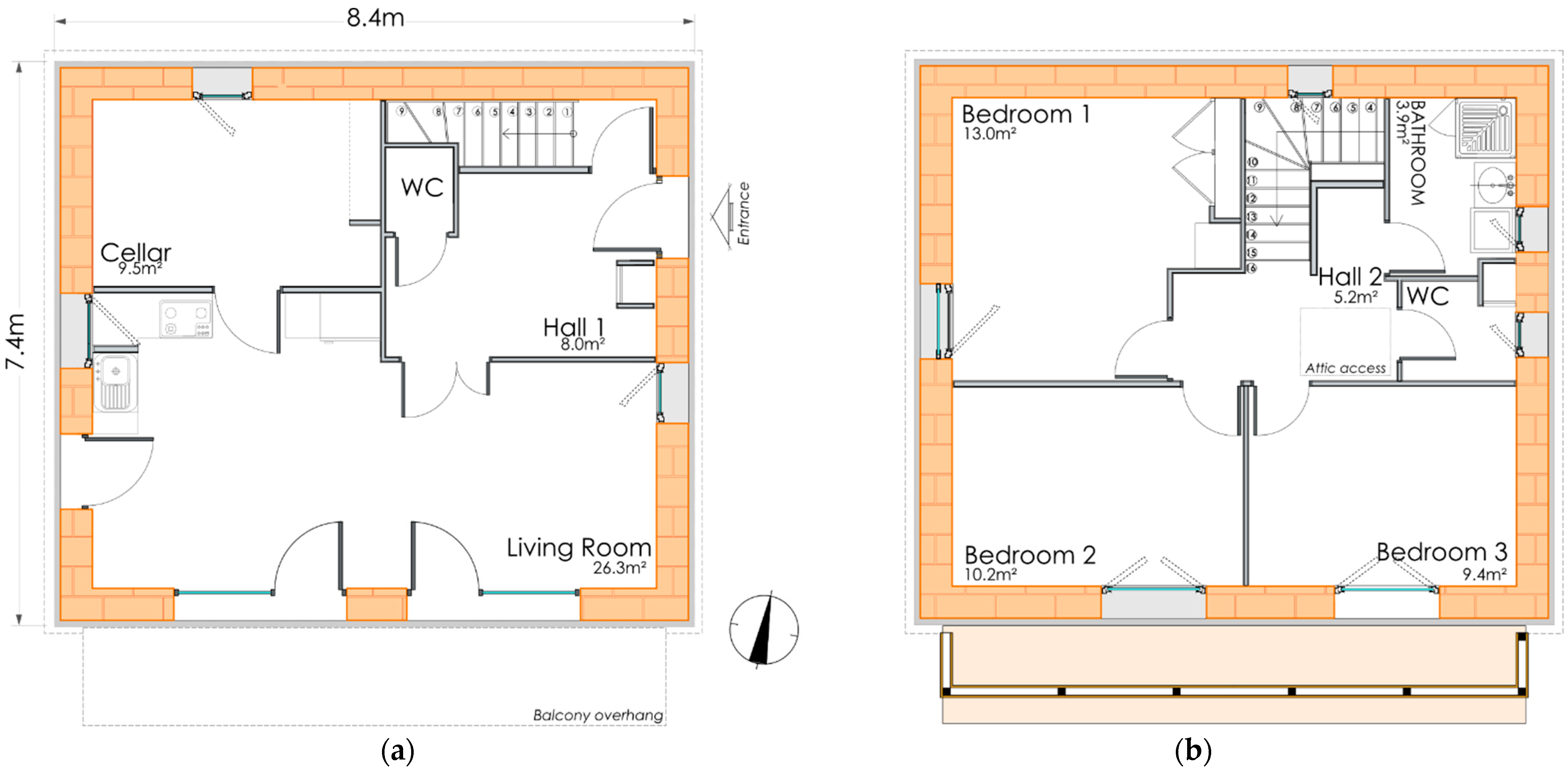
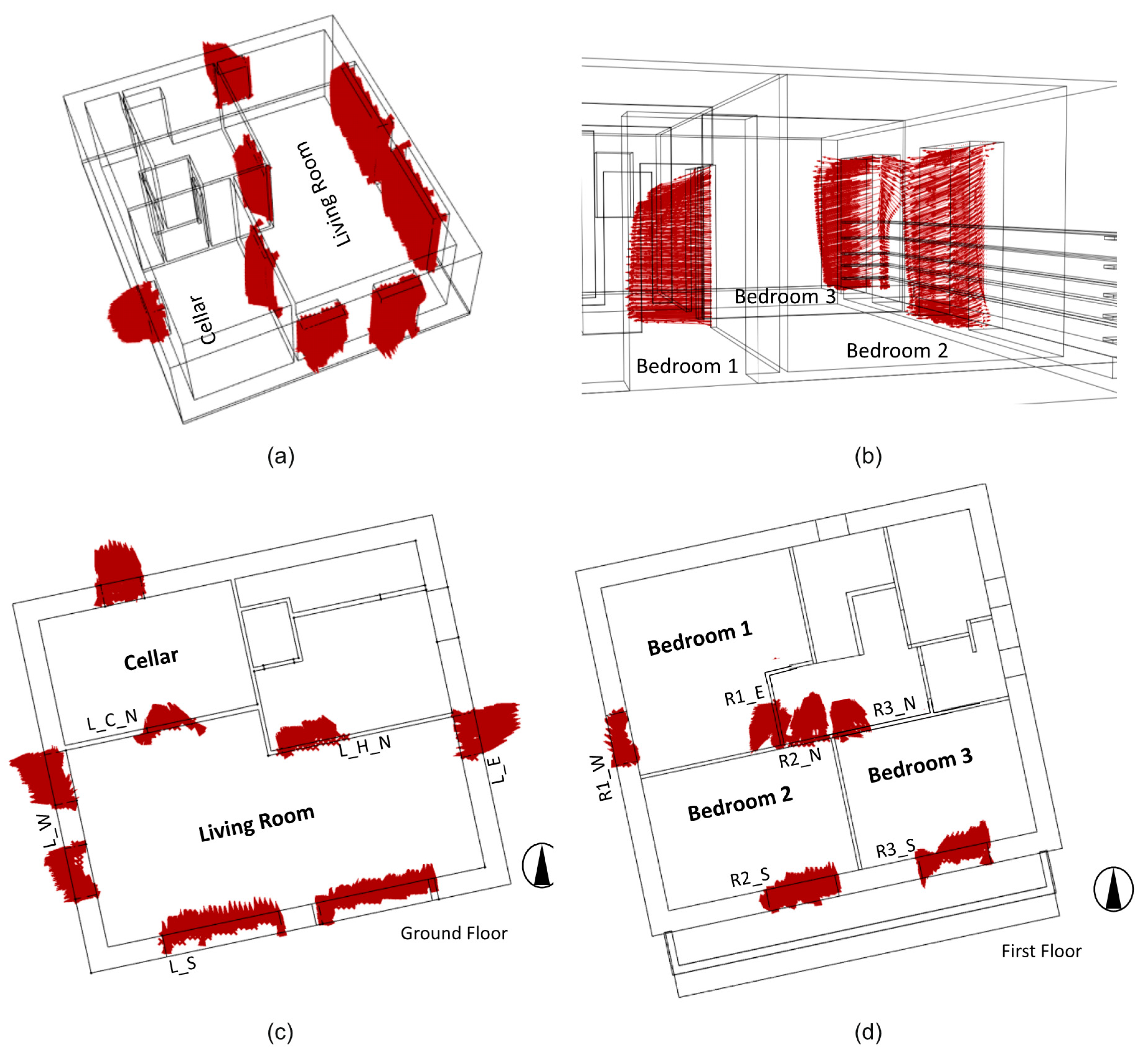
References
- Zhu, Y.; Luo, M.; Ouyang, Q.; Huang, L.; Cao, B. Dynamic characteristics and comfort assessment of airflows in indoor environments: A review. Build. Environ. 2015, 91, 5–14. [Google Scholar] [CrossRef]
- Sundell, J.; Levin, H.; Nazaroff, W.W.; Cain, W.S.; Fisk, W.J.; Grimsrund, D.T.; Gyntelberg, F.; Li, Y.; Persily, A.K.; Pickering, A.C. Ventilation rates and health: Multidisciplinary review of the scientific literature. Indoor Air 2011, 21, 191–204. [Google Scholar] [CrossRef] [PubMed]
- Chenari, B.; Dias Carrilho, J.; Gameiro da Silva, M. Towards sustainable, energy-efficient and healthy ventilation strategies in buildings: A review. Renew. Sustain. Energy Rev. 2016, 59, 1426–1447. [Google Scholar]
- European Commission. Ventilation, Good Indoor Air Quality and Rational Use of Energy, Report No 23; European Commission: Brussels, Belgium, 2003. [Google Scholar]
- DIN EN 16798-7. Energy Performance of Buildings-Ventilation For Buildings-Part 7: Calculation Methods For the Determination of Air Flow Rates in Buildings Including Infiltration; DIN EN: Berlin, Germany, 2017. [Google Scholar]
- ASHRAE. Standard 62.1-2016: Ventilation for Acceptable Indoor Air Quality; American Society of Heating, Refrigerating and Air-Conditioning Engineers: Atlanta, GA, USA, 2016. [Google Scholar]
- CIBSE. Applications Manual AM 10. Natural Ventilation in Non-Domestic Buildings; Chartered Institution of Building Services Engineers: London, UK, 2010. [Google Scholar]
- CIBSE. Guide A. Environmental Design; Chartered Institution of Building Services Engineers: London, UK, 2007. [Google Scholar]
- de Faria, L.C.; Cook, M.J.; Loveday, D.; Angelopoulos, C.; Shukla, Y.; Rawal, R.; Manu, S.; Mishra, D.; Patel, J.; Anbarasu, S. Design Charts to Assist on the Sizing of Natural Ventilation for Cooling Residential Apartments in India. In Proceedings of the 16th International Building Simulation Conference, Rome, Italy, 2–4 September 2019; pp. 696–703. [Google Scholar]
- Faggianelli, G.A.; Brun, A.; Wurtz, E.; Muselli, M. Natural cross ventilation in buildings on Mediterranean coastal zones. Energy Build 2014, 77, 206–218. [Google Scholar] [CrossRef]
- Kiwan, A.; Berg, W.; Brunsch, R.; Özcan, S.; Müller, H.-J.; Gläser, M.; Fiedler, M.; Ammon, C.; Berckmans, D. Tracer gas technique, air velocity measurement and natural ventilation method for estimating ventilation rates through naturally ventilated barns. Agric. Eng. Int. 2012, 14, 22–36. [Google Scholar]
- Brambilla, A.; Bonvin, J.; Flourentzou, F.; Jusselme, T. On the Influence of Thermal Mass and Natural Ventilation on Overheating Risk in Offices. Build. 2018, 8, 47. [Google Scholar] [CrossRef]
- Mateus, N.M.; Simões, G.N.; Lúcio, C.; da Graça, G.C. Comparison of measured and simulated performance of natural displacement ventilation systems for classrooms. Energy Build. 2016, 133, 185–196. [Google Scholar] [CrossRef]
- Weerasuriya, A.U.; Zhang, X.; Gan, V.J.L.; Tan, Y. A holistic framework to utilize natural ventilation to optimize energy performance of residential high-rise buildings. Build. Environ. 2019, 153, 218–232. [Google Scholar] [CrossRef]
- Johnson, M.-H.; Zhai, Z.; Krarti, M. Performance evaluation of network airflow models for natural ventilation. HVAC&R Res. 2012, 18, 349–365. [Google Scholar]
- Sakiyama, N.R.M.; Carlo, J.C.; Frick, J.; Garrecht, H. Perspectives of naturally ventilated buildings: A review. Renew. Sustain. Energy Rev. 2020, 130, 109933. [Google Scholar] [CrossRef]
- Chen, Q. Ventilation performance prediction for buildings: A method overview and recent applications. Build. Environ. 2009, 44, 848–858. [Google Scholar] [CrossRef]
- Porras-Amores, C.; Mazarrón, F.R.; Cañas, I.; Villoría Sáez, P. Natural ventilation analysis in an underground construction: CFD simulation and experimental validation. Tunn. Undergr. Space Technol. 2019, 90, 162–173. [Google Scholar] [CrossRef]
- Albuquerque, D.P.; Mateus, N.; Avantaggiato, M.; Carrilho da Graça, G. Full-scale measurement and validated simulation of cooling load reduction due to nighttime natural ventilation of a large atrium. Energy Build. 2020, 224, 110233. [Google Scholar] [CrossRef]
- You, W.; Qin, M.; Ding, W. Improving building facade design using integrated simulation of daylighting, thermal performance and natural ventilation. Build. Simul. 2013, 6, 269–282. [Google Scholar] [CrossRef]
- Hong, T.; Lee, M.; Kim, J. Analysis of Energy Consumption and Indoor Temperature Distributions in Educational Facility Based on CFD-BES Model. Energy Procedia 2017, 105, 3705–3710. [Google Scholar] [CrossRef]
- Elshafei, G.; Negm, A.; Bady, M.; Suzuki, M.; Ibrahim, M.G. Numerical and experimental investigations of the impacts of window parameters on indoor natural ventilation in a residential building. Energy Build. 2017, 141, 321–332. [Google Scholar] [CrossRef]
- Raji, B.; Tenpierik, M.J.; Bokel, R.; van den Dobbelsteen, A. Natural summer ventilation strategies for energy-saving in high-rise buildings: A case study in the Netherlands. Int. J. Vent. 2020, 19, 25–48. [Google Scholar] [CrossRef]
- Blocken, B. Computational Fluid Dynamics for urban physics: Importance, scales, possibilities, limitations and ten tips and tricks towards accurate and reliable simulations. Build. Environ. 2015, 91, 219–245. [Google Scholar] [CrossRef]
- de Faria, L.C.; Cook, M.J.; Loveday, D.; Angelopoulos, C.; Manu, S.; Shukla, Y. Sizing natural ventilation systems for cooling: The potential of NV systems to deliver thermal comfort while reducing energy demands of multi-storey residental buildings in india. In Proceedings of the 34th Passive and Low Energy Architecture Conference, HongKong, China, 10–12 December 2018; pp. 218–224. [Google Scholar]
- Hawendi, S.; Gao, S. Impact of an external boundary wall on indoor flow field and natural cross-ventilation in an isolated family house using numerical simulations. J. Build. Eng. 2017, 10, 109–123. [Google Scholar] [CrossRef]
- Ferrucci, M.; Brocato, M. Parametric analysis of the wind-driven ventilation potential of buildings with rectangular layout. Build. Serv. Eng. Res. Technol. 2019, 40, 109–128. [Google Scholar] [CrossRef]
- Yang, T.; Wright, N.G.; Etheridge, D.W.; Quinn, A.D. A Comparison of CFD and Full-scale Measurements for Analysis of Natural Ventilation. Int. J. Vent. 2006, 4, 337–348. [Google Scholar] [CrossRef]
- El Ahmar, S.; Battista, F.; Fioravanti, A. Simulation of the thermal performance of a geometrically complex Double-Skin Facade for hot climates: EnergyPlus vs. OpenFOAM. Build. Simul. 2019, 2, 781–795. [Google Scholar] [CrossRef]
- Ferrucci, M.; Brocato, M.; Peron, F. Digital Tools for the Morphological Design of the Naturally Ventilated Buildings. Future Cities Environ. 2018, 4, 478. [Google Scholar] [CrossRef]
- Kim R-w Hong S-w Norton, T.; Amon, T.; Youssef, A.; Berckmans, D.; Lee, I. Computational fluid dynamics for non-experts: Development of a user-friendly CFD simulator (HNVR-SYS) for natural ventilation design applications. Biosyst. Eng. 2020, 193, 232–246. [Google Scholar] [CrossRef]
- Ramponi, R.; Angelotti, A.; Blocken, B. Energy saving potential of night ventilation: Sensitivity to pressure coefficients for different European climates. Appl. Energy 2014, 123, 185–195. [Google Scholar] [CrossRef]
- Chu, C.-R.; Chiang, B.-F. Wind-driven cross ventilation in long buildings. Build. Environ. 2014, 80, 150–158. [Google Scholar] [CrossRef]
- Chu, C.-R.; Chiang, B.-F. Wind-driven cross ventilation with internal obstacles. Energy Build. 2013, 67, 201–209. [Google Scholar] [CrossRef]
- Bangalee, M.Z.I.; Lin, S.Y.; Miau, J.J. Wind driven natural ventilation through multiple windows of a building: A computational approach. Energy Build. 2012, 45, 317–325. [Google Scholar] [CrossRef]
- Shirzadi, M.; Mirzaei, P.A.; Naghashzadegan, M.; Tominaga, Y. Modelling enhancement of cross-ventilation in sheltered buildings using stochastic optimization. Int. J. Heat Mass Transf. 2018, 118, 758–772. [Google Scholar] [CrossRef]
- Zhong, H.-Y.; Jing, Y.; Sun, Y.; Kikumoto, H.; Zhao, F.-Y.; Li, Y. Wind-driven pumping flow ventilation of highrise buildings: Effects of upstream building arrangements and opening area ratios. Sci. Total. Environ. 2020, 722, 137924. [Google Scholar] [CrossRef] [PubMed]
- Arinami, Y.; Akabayashi, S.-i.; Tominaga, Y.; Sakaguchi, J. Performance evaluation of single-sided natural ventilation for generic building using large-eddy simulations: Effect of guide vanes and adjacent obstacles. Build. Environ. 2019, 154, 68–80. [Google Scholar] [CrossRef]
- Zheng, J.; Tao, Q.; Li, L. Numerical study of wind environment of a low-rise building with shading louvers: Sensitive analysis and evaluation of cross ventilation. J. Asian Archit. Build. Eng. 2020, 19, 541–558. [Google Scholar] [CrossRef]
- Castillo, J.A.; Huelsz, G.; van Hooff, T.; Blocken, B. Natural ventilation of an isolated generic building with a windward window and different windexchangers: CFD validation, sensitivity study and performance analysis. Build. Simul. 2019, 12, 475–488. [Google Scholar] [CrossRef]
- Gautam, K.R.; Rong, L.; Zhang, G.; Abkar, M. Comparison of analysis methods for wind-driven cross ventilation through large openings. Build. Environ. 2019, 154, 375–388. [Google Scholar] [CrossRef]
- Pakari, A.; Ghani, S. Airflow assessment in a naturally ventilated greenhouse equipped with wind towers: Numerical simulation and wind tunnel experiments. Energy Build. 2019, 199, 1–11. [Google Scholar] [CrossRef]
- Dai, Y.W.; Mak, C.M.; Ai, Z.T. Computational fluid dynamics simulation of wind-driven inter-unit dispersion around multi-storey buildings: Upstream building effect. Indoor Built Environ. 2019, 28, 217–234. [Google Scholar] [CrossRef]
- Gough, H.; King, M.-F.; Nathan, P.; Grimmond, C.S.B.; Robins, A.; Noakes, C.J.; Luo, C.; Barlow, J.F. Influence of neighbouring structures on building façade pressures: Comparison between full-scale, wind-tunnel, CFD and practitioner guidelines. J. Wind Eng. Ind. Aerodyn. 2019, 189, 22–33. [Google Scholar] [CrossRef]
- Hirose, C.; Ikegaya, N.; Hagishima, A.; Tanimoto, J. Outdoor measurement of wall pressure on cubical scale model affected by atmospheric turbulent flow. Build. Environ. 2019, 160, 106170. [Google Scholar] [CrossRef]
- Lo, L.J.; Novoselac, A. Cross ventilation with small openings: Measurements in a multi-zone test building. Build. Environ. 2012, 57, 377–386. [Google Scholar] [CrossRef]
- Hayati, A.; Mattsson, M.; Sandberg, M. A wind tunnel study of wind-driven airing through open doors. Int. J. Vent. 2019, 18, 113–135. [Google Scholar] [CrossRef]
- Tecle, A.; Bitsuamlak, G.T.; Jiru, T.E. Wind-driven natural ventilation in a low-rise building: A Boundary Layer Wind Tunnel study. Build. Environ. 2013, 59, 275–289. [Google Scholar] [CrossRef]
- Shirzadi, M.; Tominaga, Y.; Mirzaei, P.A. Wind tunnel experiments on cross-ventilation flow of a generic sheltered building in urban areas. Build. Environ. 2019, 158, 60–72. [Google Scholar] [CrossRef]
- Hensen, J.; Lamberts, R. Building Performance Simulation for Design and Operation; Spon Press: London, UK; New York, NY, USA, 2011. [Google Scholar]
- Zhai, Z.J.; Zhang, Z.; Zhang, W.; Chen, Q.Y. Evaluation of Various Turbulence Models in Predicting Airflow and Turbulence in Enclosed Environments by CFD: Part 1—Summary of Prevalent Turbulence Models. HVAC&R Res. 2007, 13, 853–870. [Google Scholar] [CrossRef]
- Zhang, Z.; Zhang, W.; Zhai, Z.J.; Chen, Q.Y. Evaluation of Various Turbulence Models in Predicting Airflow and Turbulence in Enclosed Environments by CFD: Part 2—Comparison with Experimental Data from Literature. HVAC&R Res. 2007, 13, 871–886. [Google Scholar] [CrossRef]
- Jiang y Alexander, D.; Jenkins, H.; Arthur, R.; Chen, Q. Natural ventilation in buildings: Measurement ina wind tunnel and numerical simulation with large-eddy simulation. J. Wind. Eng. Ind. Aerodyn. 2003, 91, 331–353. [Google Scholar] [CrossRef]
- Jiang y Chen, Q. Study of natural ventilation in buildings by large eddy simulation. J. Wind Eng. Ind. Aerodyn. 2001, 89, 1155–1178. [Google Scholar] [CrossRef]
- Wright, N.G.; Hargreaves, D.M. Unsteady CFD Simulations for Natural Ventilation. Int. J. Vent. 2006, 5, 13–20. [Google Scholar] [CrossRef]
- Bu, Z.; Kato, S. Wind-induced ventilation performances and airflow characteristics in an areaway-attached basement with a single-sided opening. Build. Environ. 2011, 46, 911–921. [Google Scholar] [CrossRef]
- Sherman, M.H. Tracer-gas techniques for measuring ventilation in a single zone. Build. Environ. 1990, 25, 365–374. [Google Scholar] [CrossRef]
- Laußmann, D.; Helm, D. Air Change Measurements Using Tracer Gases: Methods and Results. Significance of Air Change for Indoor Air Quality; Epidemiologie und Gesundheitsberichterstattung, Robert Koch-Institut: Berlin, Germany, 2011. [Google Scholar]
- Caciolo, M.; Stabat, P.; Marchio, D. Numerical simulation of single-sided ventilation using RANS and LES and comparison with full-scale experiments. Build. Environ. 2012, 50, 202–213. [Google Scholar] [CrossRef]
- Zhang, X.; Weerasuriya, A.U.; Tse, K.T. CFD simulation of natural ventilation of a generic building in various incident wind directions: Comparison of turbulence modelling, evaluation methods, and ventilation mechanisms. Energy Build. 2020, 229, 110516. [Google Scholar] [CrossRef]
- Tong, Z.; Chen, Y.; Malkawi, A. Defining the Influence Region in neighborhood-scale CFD simulations for natural ventilation design. Appl. Energy 2016, 182, 625–633. [Google Scholar] [CrossRef]
- Deng, X.; Tan, Z. Numerical analysis of local thermal comfort in a plan office under natural ventilation. Indoor Built Environ. 2020, 29, 972–986. [Google Scholar] [CrossRef]
- Subhashini, S.; Thirumaran, K. CFD simulations for examining natural ventilation in the learning spaces of an educational building with courtyards in Madurai. Build. Serv. Eng. Res. Technol. 2020, 41, 466–479. [Google Scholar] [CrossRef]
- Saadatjoo, P.; Mahdavinejad, M.; Zhang, G. A study on terraced apartments and their natural ventilation performance in hot and humid regions. Build. Simul. 2018, 11, 359–372. [Google Scholar] [CrossRef]
- Cândido, C.; de Dear, R.; Lamberts, R. Combined thermal acceptability and air movement assessments in a hot humid climate. Build. Environ. 2011, 46, 379–385. [Google Scholar] [CrossRef]
- Huang, L.; Ouyang, Q.; Zhu, Y.; Jiang, L. A study about the demand for air movement in warm environment. Build. Environ. 2013, 61, 27–33. [Google Scholar] [CrossRef]
- Bayoumi, M. Improving Natural Ventilation Conditions on Semi-Outdoor and Indoor Levels in Warm–Humid Climates. Buildings 2018, 8, 75. [Google Scholar] [CrossRef]
- ASHRAE. Standard 55: Thermal Environmental Conditions for Human Occupancy; ASHRAE: New York, NY, USA, 2013. [Google Scholar]
- DIN EN 16798-1. Energy Performance of Buildings-Ventilation for Buildings-Part 1: Indoor Environmental Input Parameters for Design and Assessment of Energy Performance of Buildings Addressing Indoor Air Quality, Thermal Environment, Lighting and Acoustics-Module M1-6.(16798-1); DIN EN: Berlin, Germany, 2019. [Google Scholar]
- Spentzou, E.; Cook, M.J.; Emmitt, S. Modelling natural ventilation for summer thermal comfort in Mediterranean dwellings. Int. J.Vent. 2019, 18, 28–45. [Google Scholar] [CrossRef]
- Robert McNeel & Associates Rhinoceros 3D 5 for Windows and Mac, Seattle, WA, USA. Available online: https://www.rhino3d.com/ (accessed on 23 November 2020).
- Davidson, S. Grasshopper. Available online: https://www.grasshopper3d.com/ (accessed on 23 November 2020).
- Wang, B.; Malkawi, A. Genetic Algorithm Based Building Form Optimization Study for Natural Ventilation Potential. In Proceedings of the 14th International Building Simulation Conference, Hyderabad, India, 7–9 December 2015; pp. 640–647. [Google Scholar]
- Yoon, N.; Piette, M.A.; Han, J.M.; Wu, W.; Malkawi, A. Optimization of Window Positions for Wind-Driven Natural Ventilation Performance. Energies 2020, 13, 2464. [Google Scholar] [CrossRef]
- Mackey, C.; Galanos, T.; Norford, L.; Roudsari, M.S. Wind, Sun, Surface Temperature, and Heat Island: Critical Variables for High-resolution Outdoor Thermal Comfort. In Proceedings of the 15th International Building Simulation Conference, San Francisco, CA, USA, 7–9 August 2017; pp. 985–993. [Google Scholar]
- Ganji, H.B.; Utzinger, D.M.; Bradley, D.E. Create and Validate Hybrid Ventilation Components in Simulation using Grasshopper and Python in Rhinoceros. In Proceedings of the 16th International Building Simulation Conference, Rome, Italy, 2–4 September 2019; pp. 4345–4352. [Google Scholar]
- Roudsari, M.S.; Mackey, C. Butterfly. Ladybug Tools Butterfly. Available online: https://www.ladybug.tools/butterfly.html (accessed on 23 November 2020).
- Sakiyama, N.R.M.; Mazzaferro, L.; Carlo, J.C.; Bejat, T.; Garrecht, H. Natural ventilation potential from weather analyses and building simulation. Energy Build. 2020, 231, 110596. [Google Scholar] [CrossRef]
- Ji, L.; Tan, H.; Kato, S.; Bu, Z.; Takahashi, T. Wind tunnel investigation on influence of fluctuating wind direction on cross natural ventilation. Build. Environ. 2011, 46, 2490–2499. [Google Scholar] [CrossRef]
- Roudsari, M.S.; Pak, M.; Smith, A. Ladybug: A parametric environmental plugin for grasshopper to help designers create an environmentally-conscious design. In Proceedings of the 13th International Building Simulation Conference, Chambéry, France, 26–28 August 2013; pp. 3128–3135. [Google Scholar]
- Gandemer, J.; Barnaud, G. Guide Sur La Climatisation Naturelle De l’habitat En Climat Tropical Humide; Centre Scientifique Et Technique Du Bâtiment: Marne LaVale, France, 1997. [Google Scholar]
- Calif, R.; Schmitt, F.G. Modeling of atmospheric wind speed sequence using a lognormal continuous stochastic equation. J. Wind Eng. Ind. Aerodyn. 2012, 109, 1–8. [Google Scholar] [CrossRef]
- Garcia, A.; Torres, J.L.; Prieto, E.; Francisco, A.D.E. Fitting wind speed distributions: A case study. Sol. Energy 1998, 62, 139–144. [Google Scholar] [CrossRef]
- OpenCFD Ltd. OpenFOAM: v1219 User Guide Openfoam. Available online: https://www.openfoam.com/documentation/user-guide/ (accessed on 23 November 2020).
- Gartmann, A.; Fister, W.; Schwanghart, W.; Müller, M.D. CFD modelling and validation of measured wind field data in a portable wind tunnel. Aeolian Res. 2011, 3, 315–325. [Google Scholar] [CrossRef]
- Kubilay, A.; Derome, D.; Blocken, B.; Carmeliet, J. Numerical simulations of wind-driven rain on an array of low-rise cubic buildings and validation by field measurements. Build. Environ. 2014, 81, 283–295. [Google Scholar] [CrossRef]
- Ramponi, R.; Blocken, B. CFD simulation of cross-ventilation for a generic isolated building: Impact of computational parameters. Build. Environ. 2012, 53, 34–48. [Google Scholar] [CrossRef]
- Tan, G.; Glicksman, L.R. Application of integrating multi-zone model with CFD simulation to natural ventilation prediction. Energy Build. 2005, 37, 1049–1057. [Google Scholar] [CrossRef]
- Tominaga, Y.; Mochida, A.; Yoshie, R.; Kataoka, H.; Nozu, T.; Yoshikawa, M.; Shirasawa, T. AIJ guidelines for practical applications of CFD to pedestrian wind environment around buildings. J. Wind Eng. Ind. Aerodyn. 2008, 96, 1749–1761. [Google Scholar] [CrossRef]
- Muhsin, F.; Yusoff, W.F.M.; Mohamed, M.F.; Sapian, A.R. CFD modeling of natural ventilation in a void connected to the living units of a multi-storey housing for thermal comfort. Energy Build. 2017, 144, 1–16. [Google Scholar] [CrossRef]
- Cebeci, T.; Shao, J.P.; Kafyeke, F.; Laurendeau, E. Computational Fluid Dynamics for Engineers: From Panel to navier-Stokes Methods with Computer Programs; Springer Berlin Heidelberg: Heidelberg, Germany, 2005. [Google Scholar]
- Chen, Q.; Lee, K.; Mazumdar, S.; Poussou, S.; Wang, L.; Wang, M.; Zhang, Z. Ventilation performance prediction for buildings: Model assessment. Build. Environ. 2010, 45, 295–303. [Google Scholar] [CrossRef]
- Cheung, J.O.P.; Liu, C.-H. CFD simulations of natural ventilation behaviour in high-rise buildings in regular and staggered arrangements at various spacings. Energy Build. 2011, 43, 1149–1158. [Google Scholar] [CrossRef]
- Farea, T.G.; Ossen, D.R.; Alkaff, S.; Kotani, H. CFD modeling for natural ventilation in a lightwell connected to outdoor through horizontal voids. Energy Build. 2015, 86, 502–513. [Google Scholar] [CrossRef]
- Patankar, S.V.; Spalding, D.B. A calculation procedure for heat, mass and momentum transfer in three-dimensional parabolic flows. Int. J. Heat Mass Transf. 1972, 15, 1787–1806. [Google Scholar] [CrossRef]
- Versteeg, H.K.; Malalasekera, W. An Introduction to Computational Fluid Dynamics: The Finite Volume Method, 2nd ed.; Pearson Education Ltd.: Harlow, UK; New York, NY, USA, 2007. [Google Scholar]
- Warming, R.F.; Beam, R.M. Upwind Second-Order Difference Schemes and Applications in Aerodynamic Flows. AIAA J. 1976, 14, 1241–1249. [Google Scholar] [CrossRef]
- Kitware Inc. ParaView. Available online: https://www.paraview.org/ (accessed on 23 November 2020).
- Hargreaves, D.M.; Wright, N.G. On the use of the k– model in commercial CFD software to model the neutral atmospheric boundary layer. J. Wind Eng. Industrial Aerodyn. 2007, 95, 355–369. [Google Scholar] [CrossRef]
- Hammond, D.S.; Chapman, L.; Thornes, J.E. Roughness length estimation along road transects using airborne LIDAR data. Meteorol. Appl. 2012, 19, 420–426. [Google Scholar] [CrossRef]
- Fangquing, L. A Thorough Description Of How Wall Functions are implemented in OpenFoam. In Proceedings of CFD with OpenSource Software, 2016, Edited by Nilsson. H. Available online: http://www.tfd.chalmers.se/~hani/kurser/OS_CFD_2016/FangqingLiu/openfoamFinal.pdf (accessed on 23 November 2020).
- Lukiantchuki, M.A.; Shimomura, A.P.; Silva FMd Caram, R.M. Evaluation of CFD simulations with wind tunnel experiments: Pressure coefficients at openings in sawtooth building. Acta Sci. Technol. 2018, 40, 37537. [Google Scholar] [CrossRef]
- Rong, L.; Nielsen, P.V.; Bjerg, B.; Zhang, G. Summary of best guidelines and validation of CFD modeling in livestock buildings to ensure prediction quality. Comput. Electron. Agric. 2016, 121, 180–190. [Google Scholar] [CrossRef]
- Karava, P.; Stathopoulos, T.; Athienitis, A.K. Airflow assessment in cross-ventilated buildings with operable façade elements. Build. Environ. 2011, 46, 266–279. [Google Scholar] [CrossRef]
- Liu, T.; Lee, W.L. Influence of window opening degree on natural ventilation performance of residential buildings in Hong Kong. Sci. Technol. Built Environ. 2020. [Google Scholar] [CrossRef]
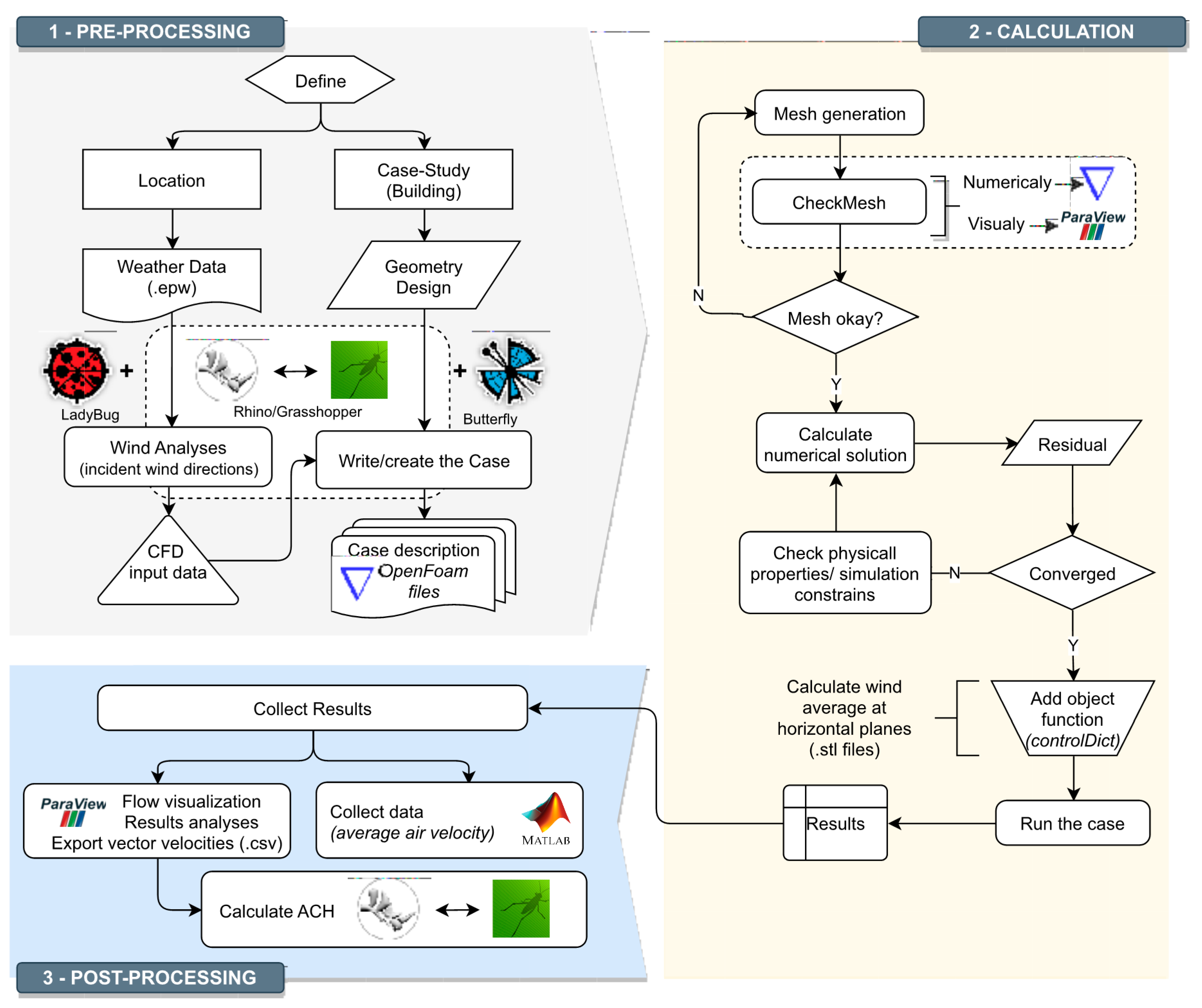
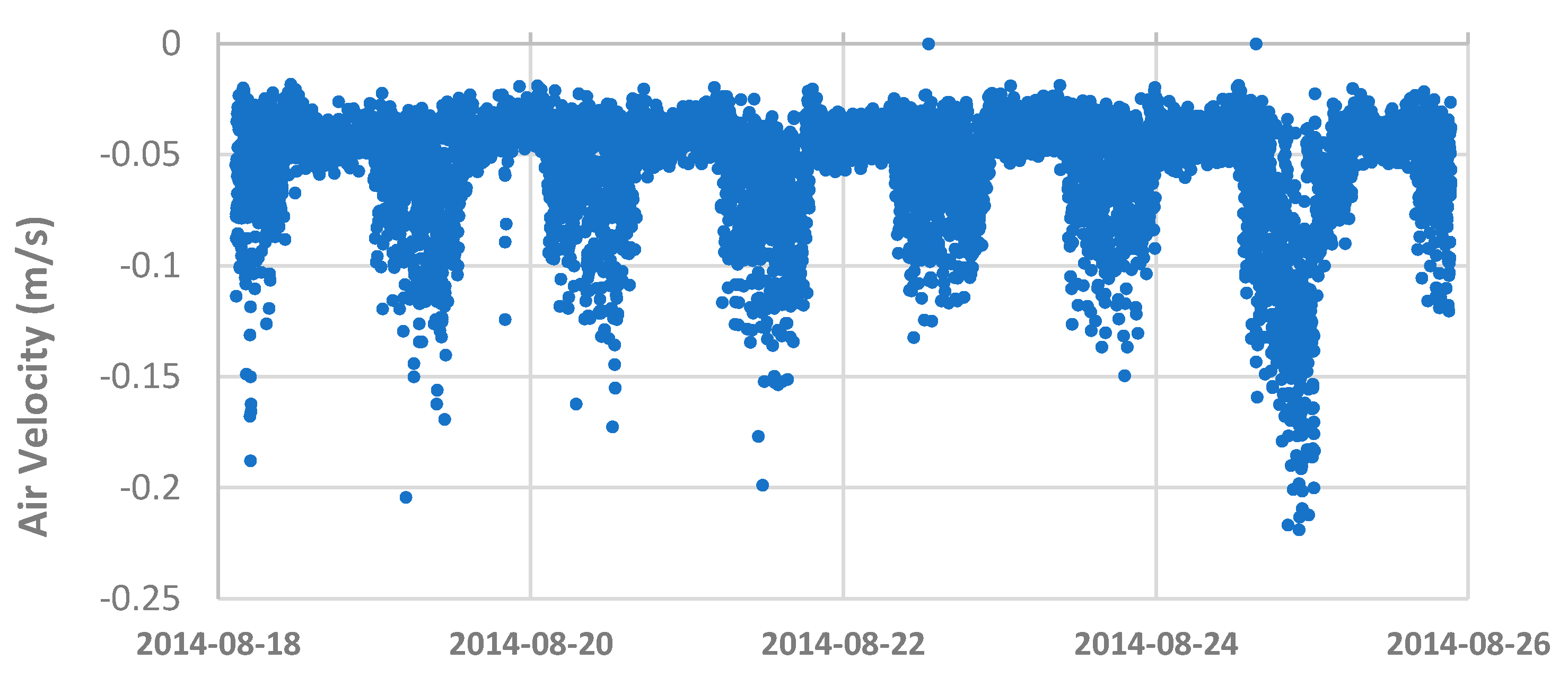
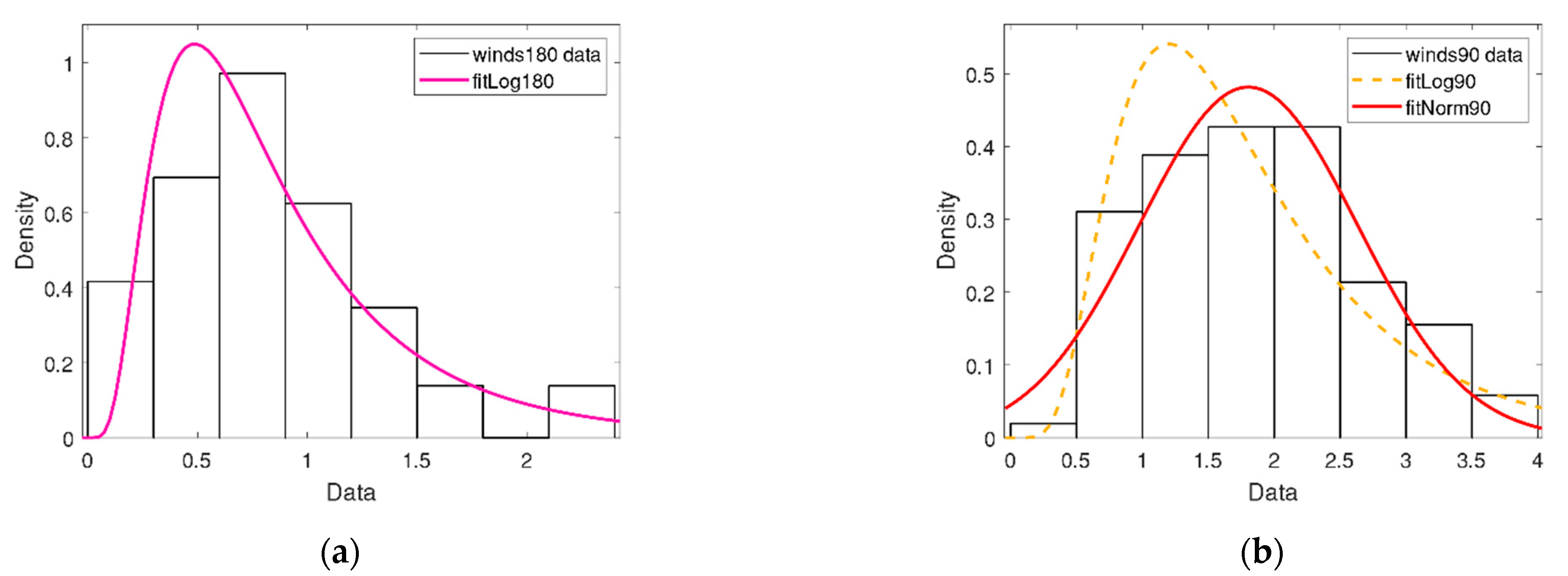
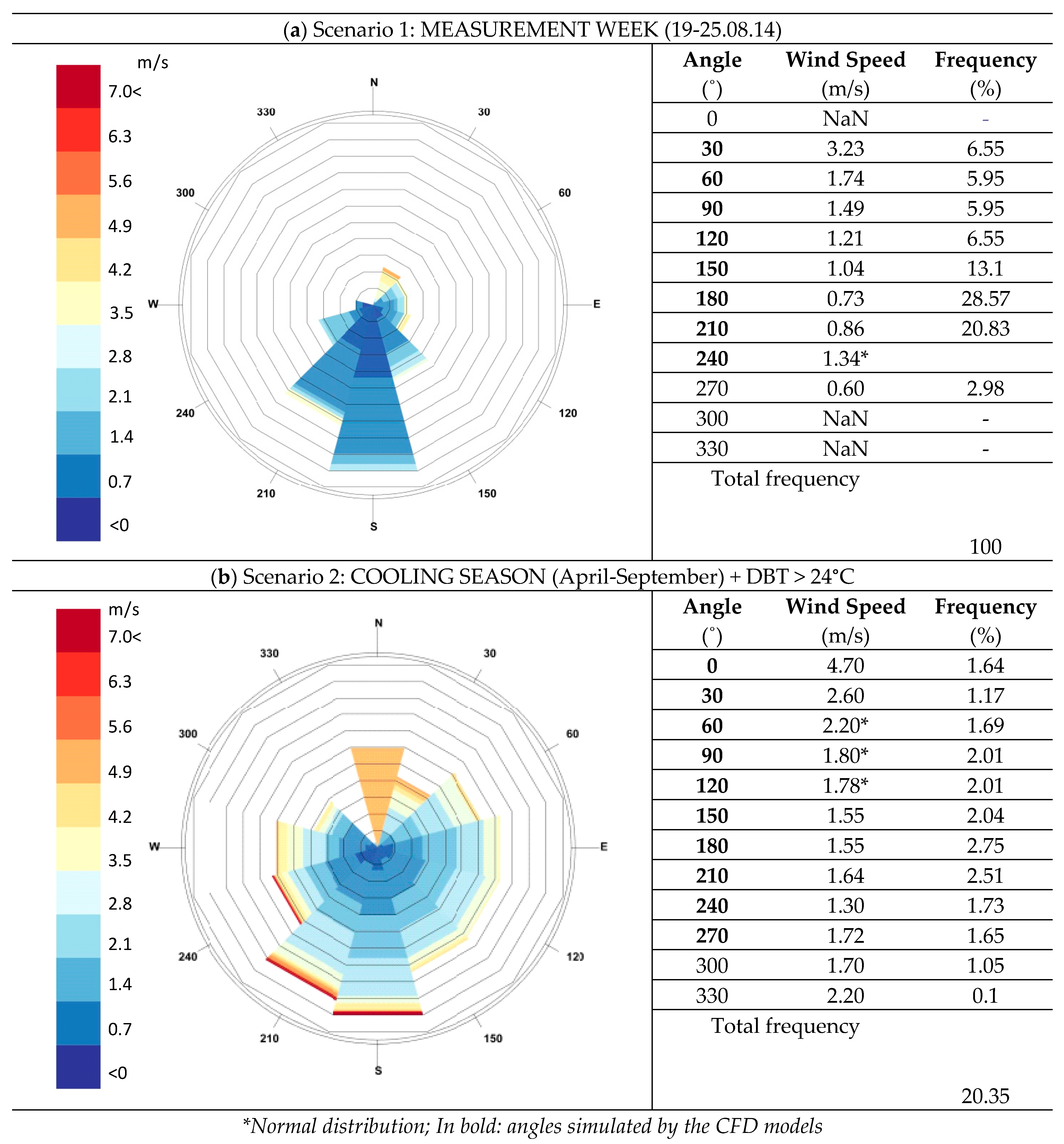
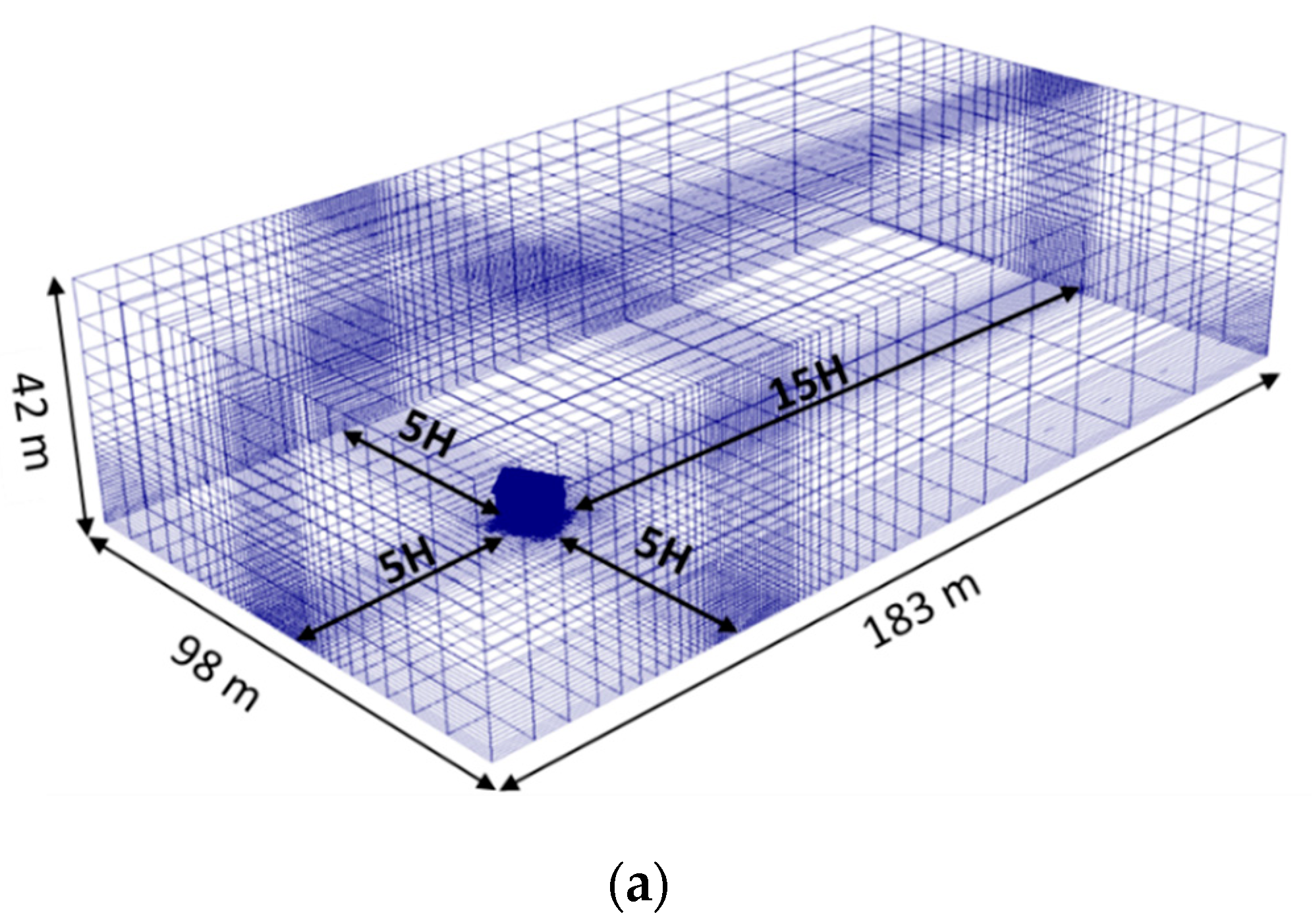
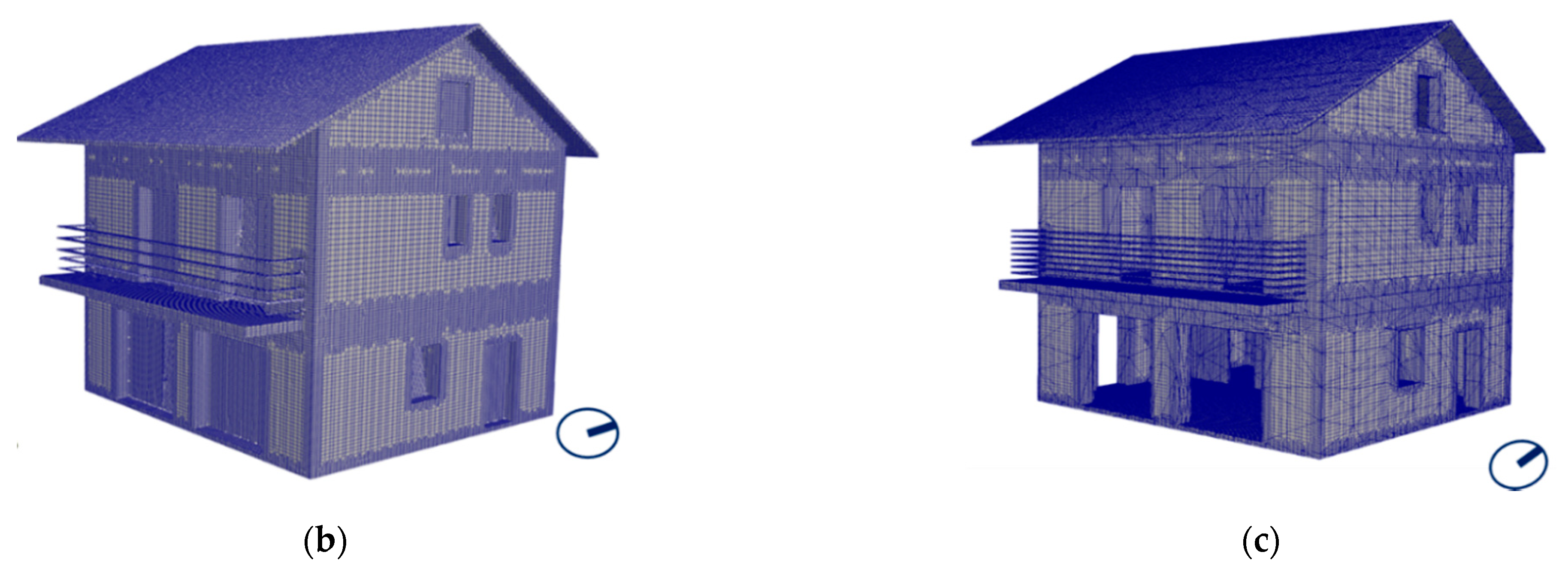
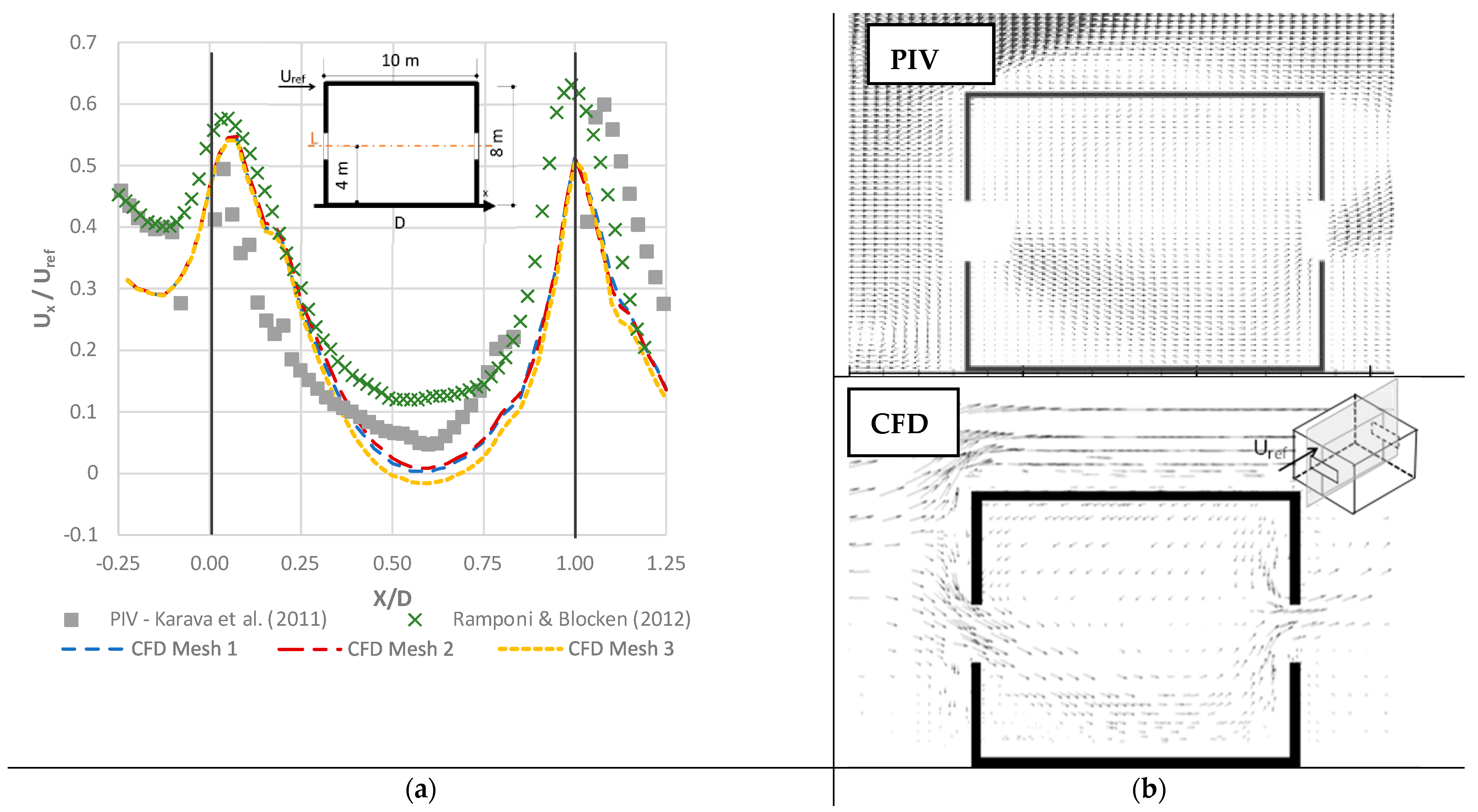

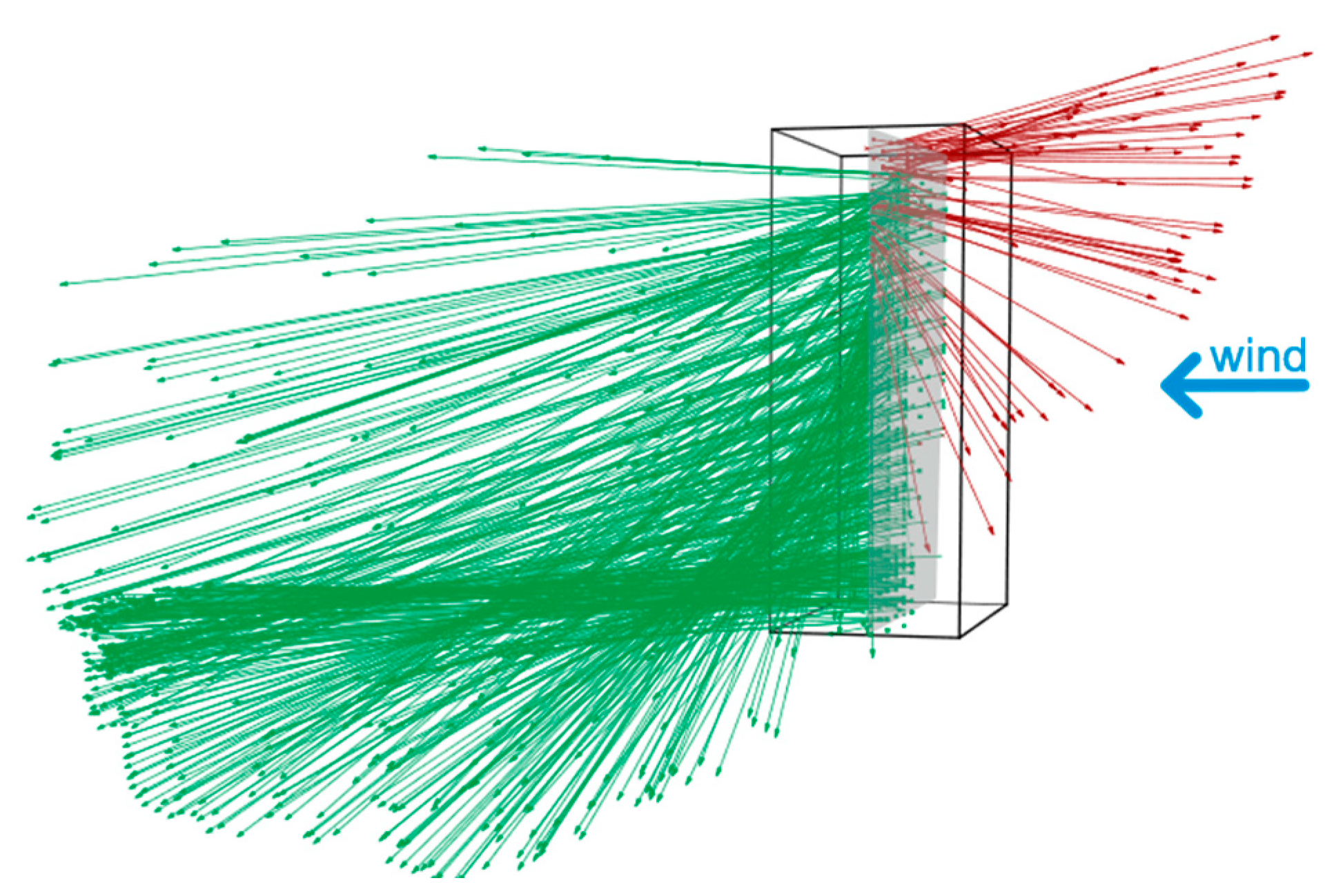
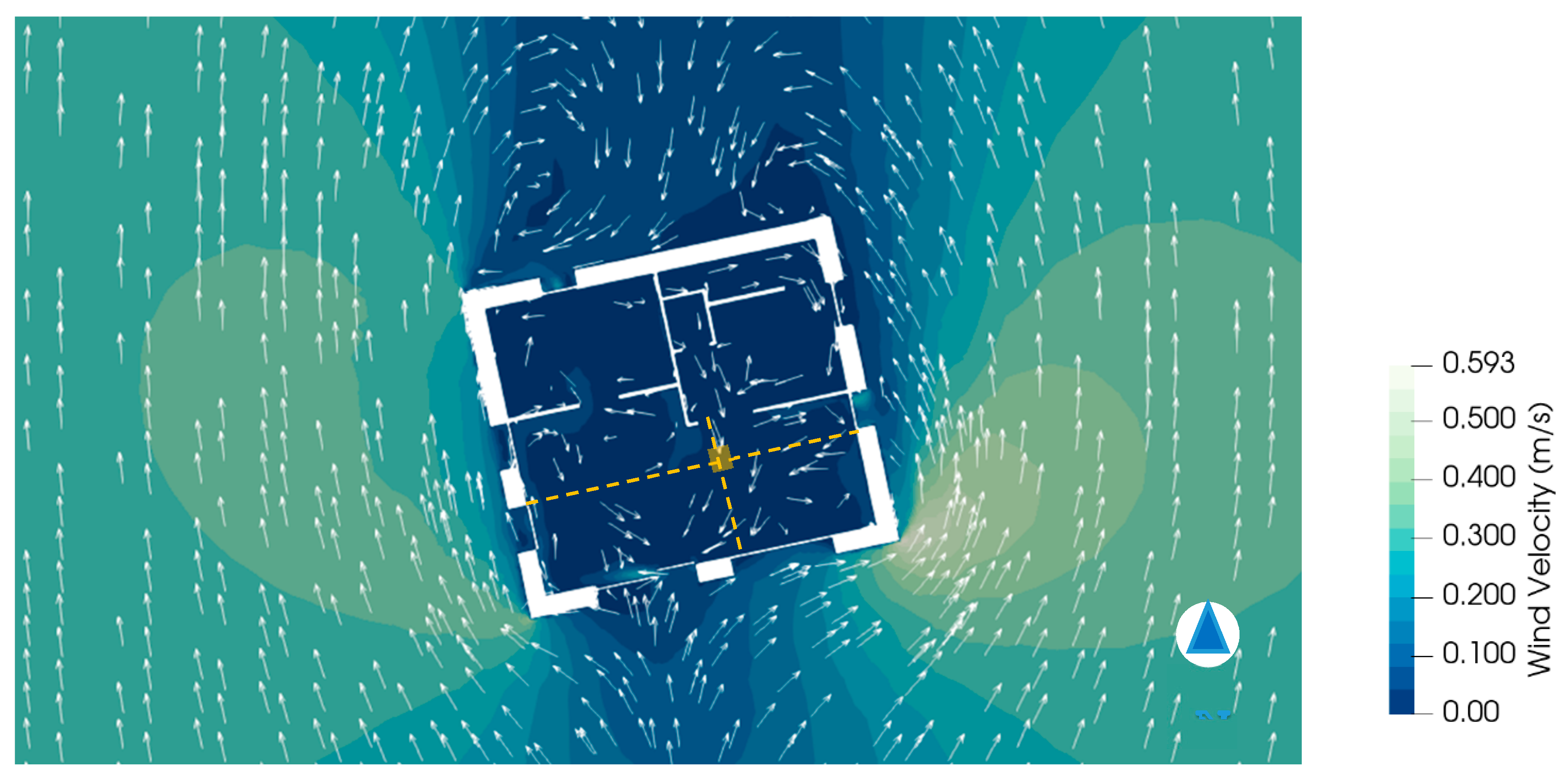
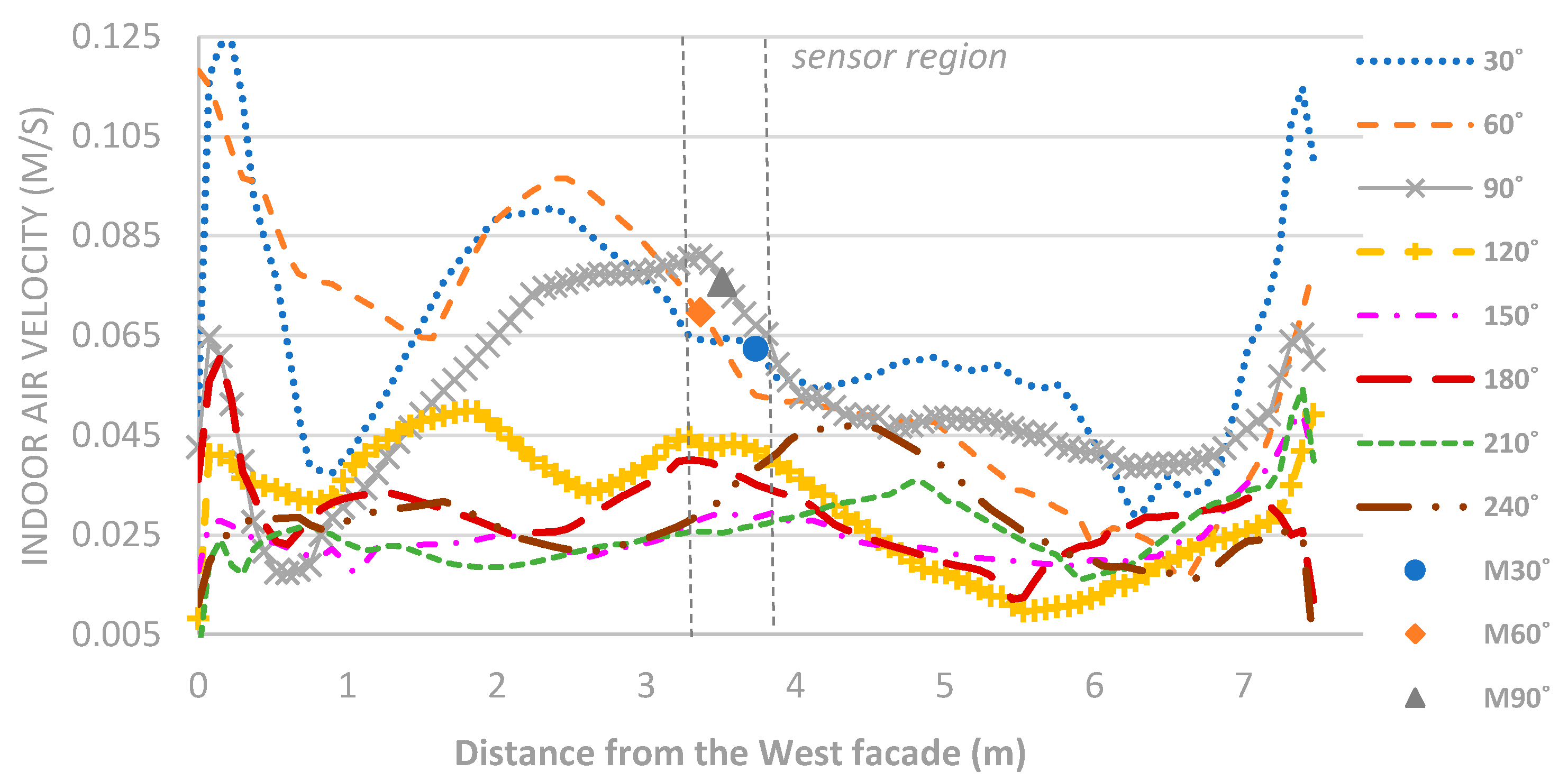
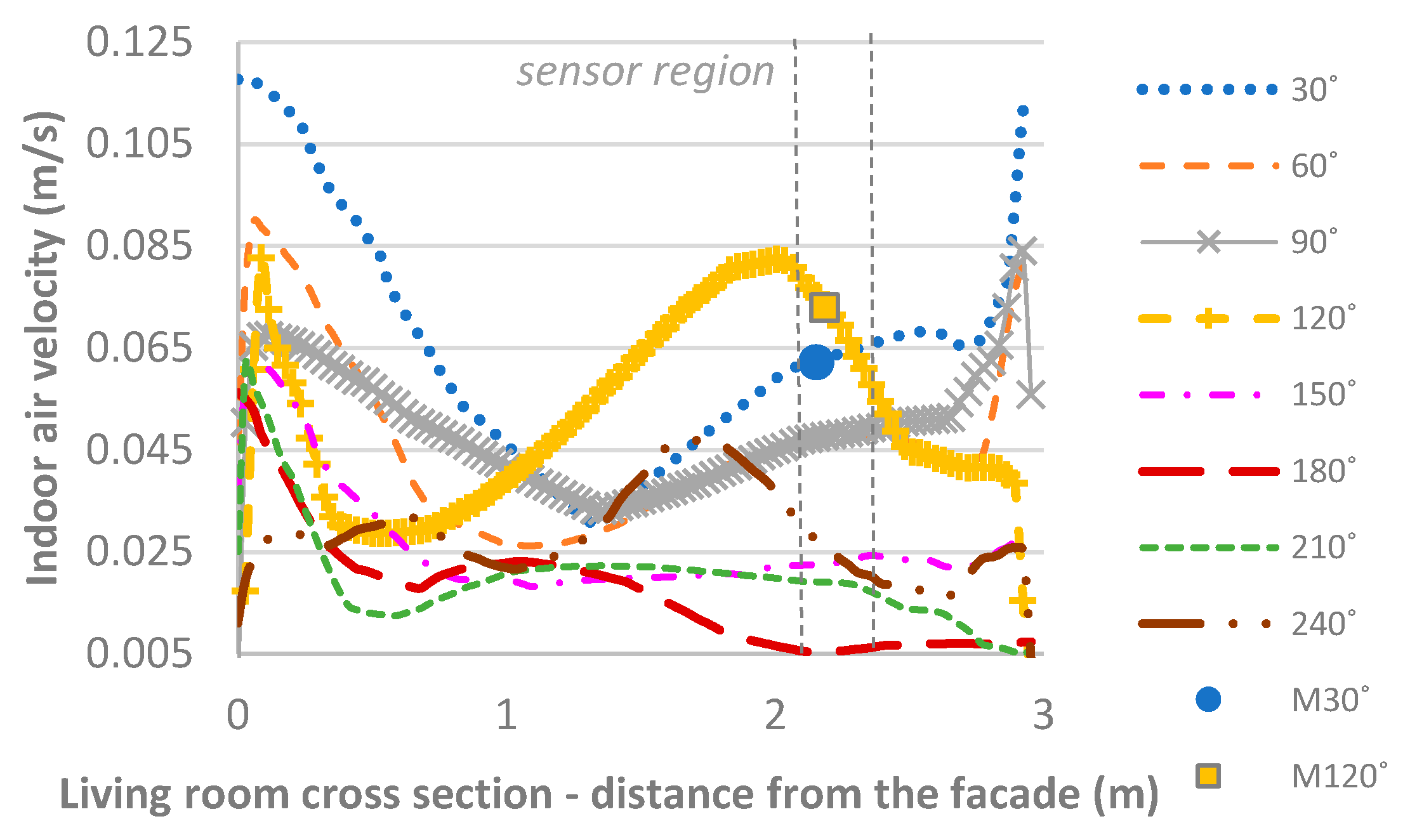
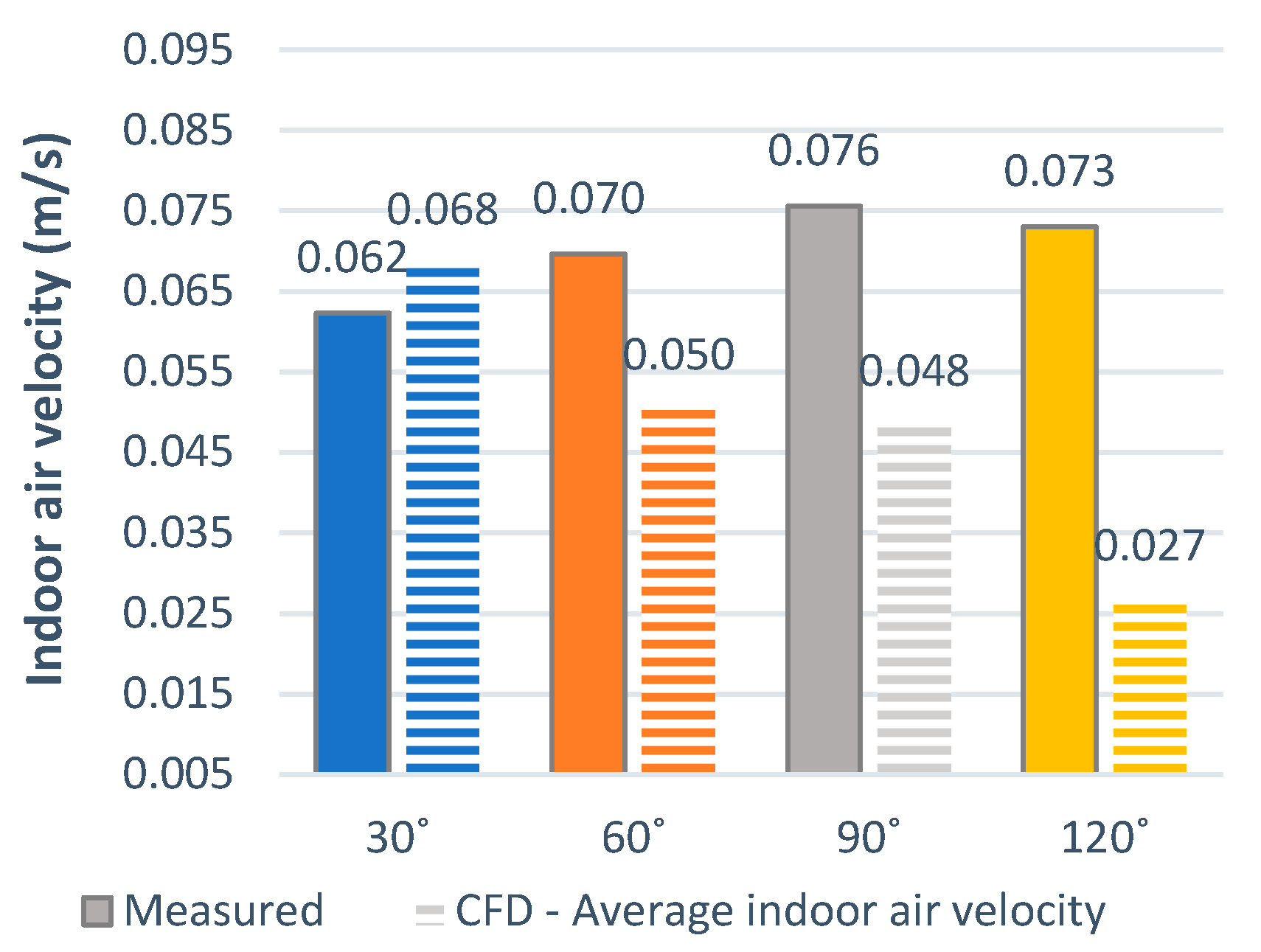
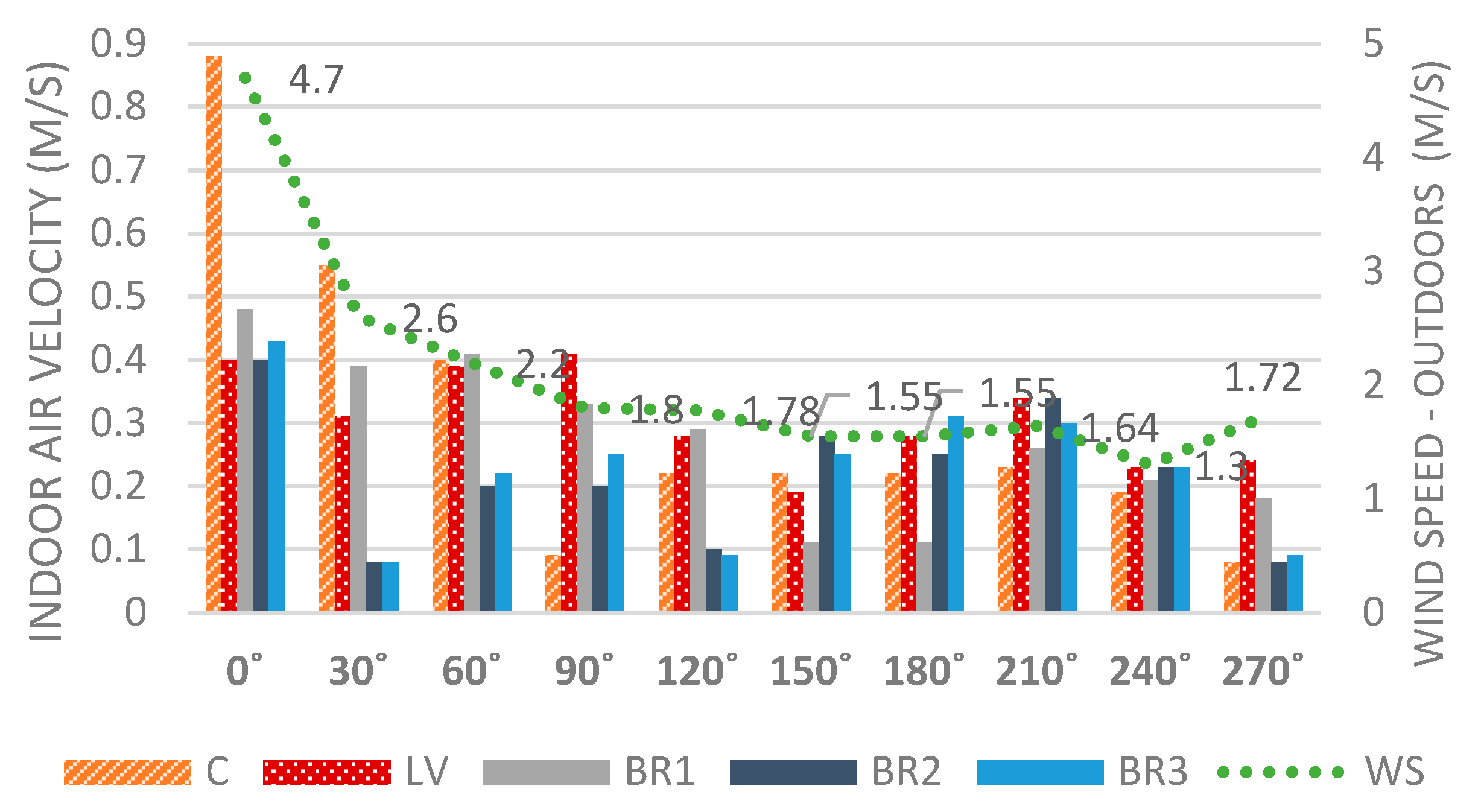
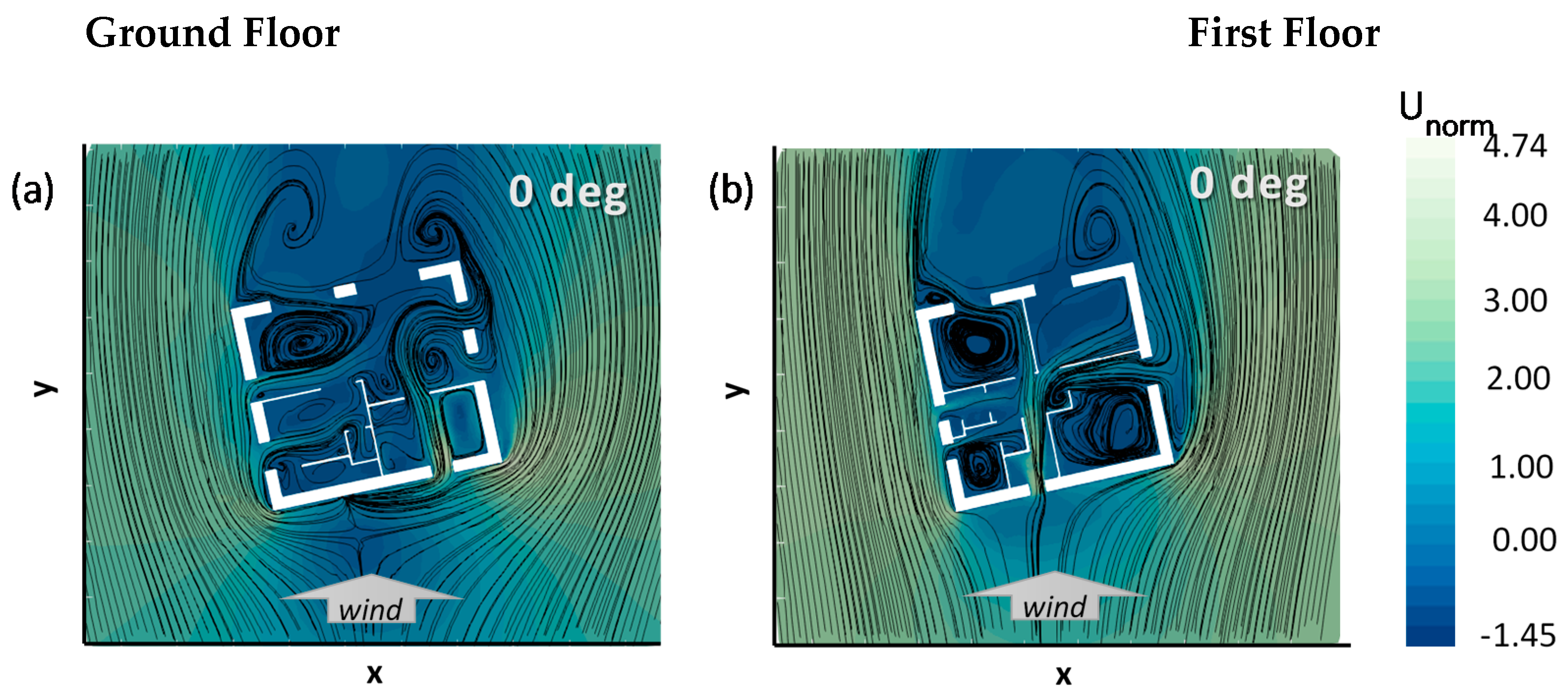
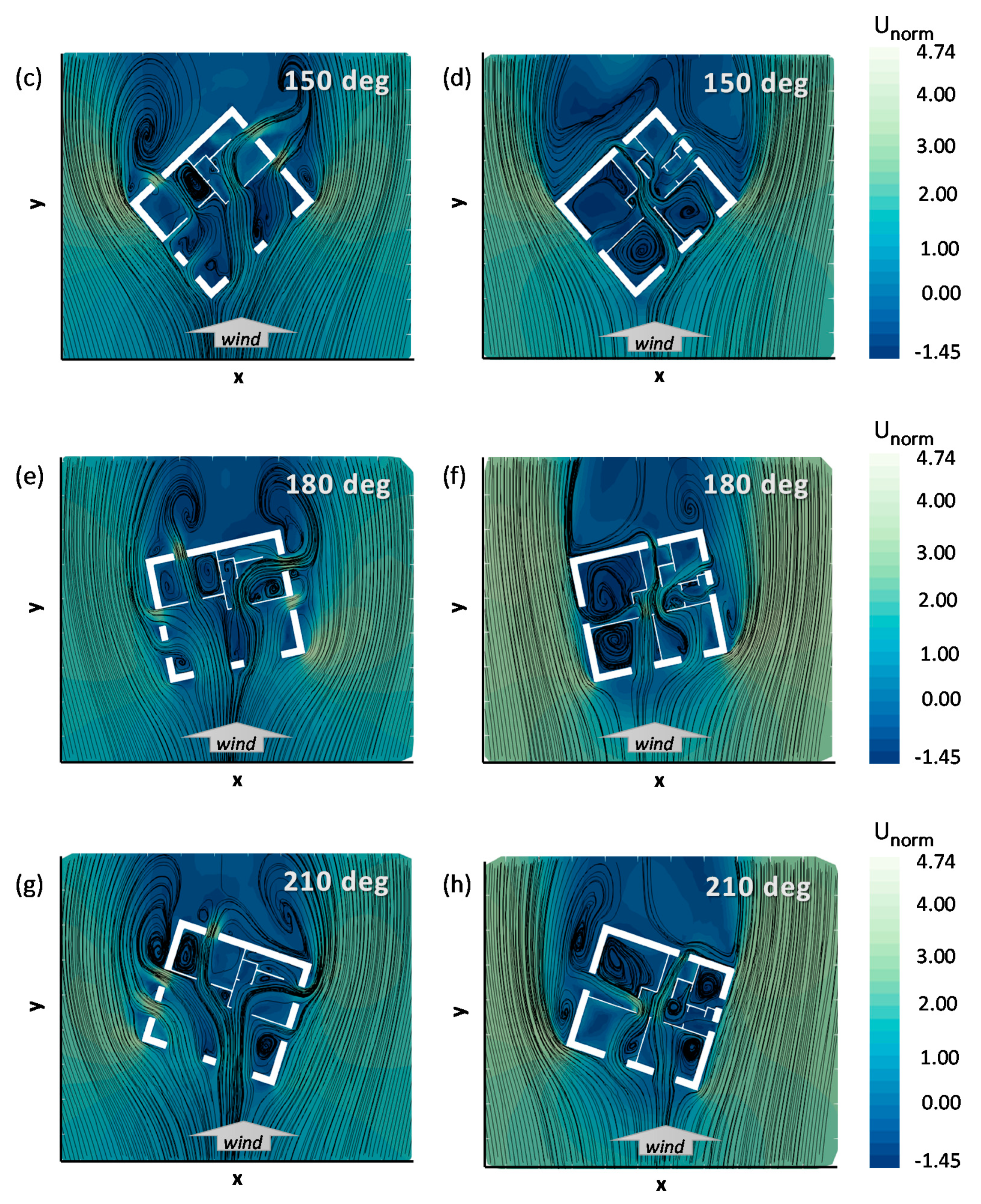
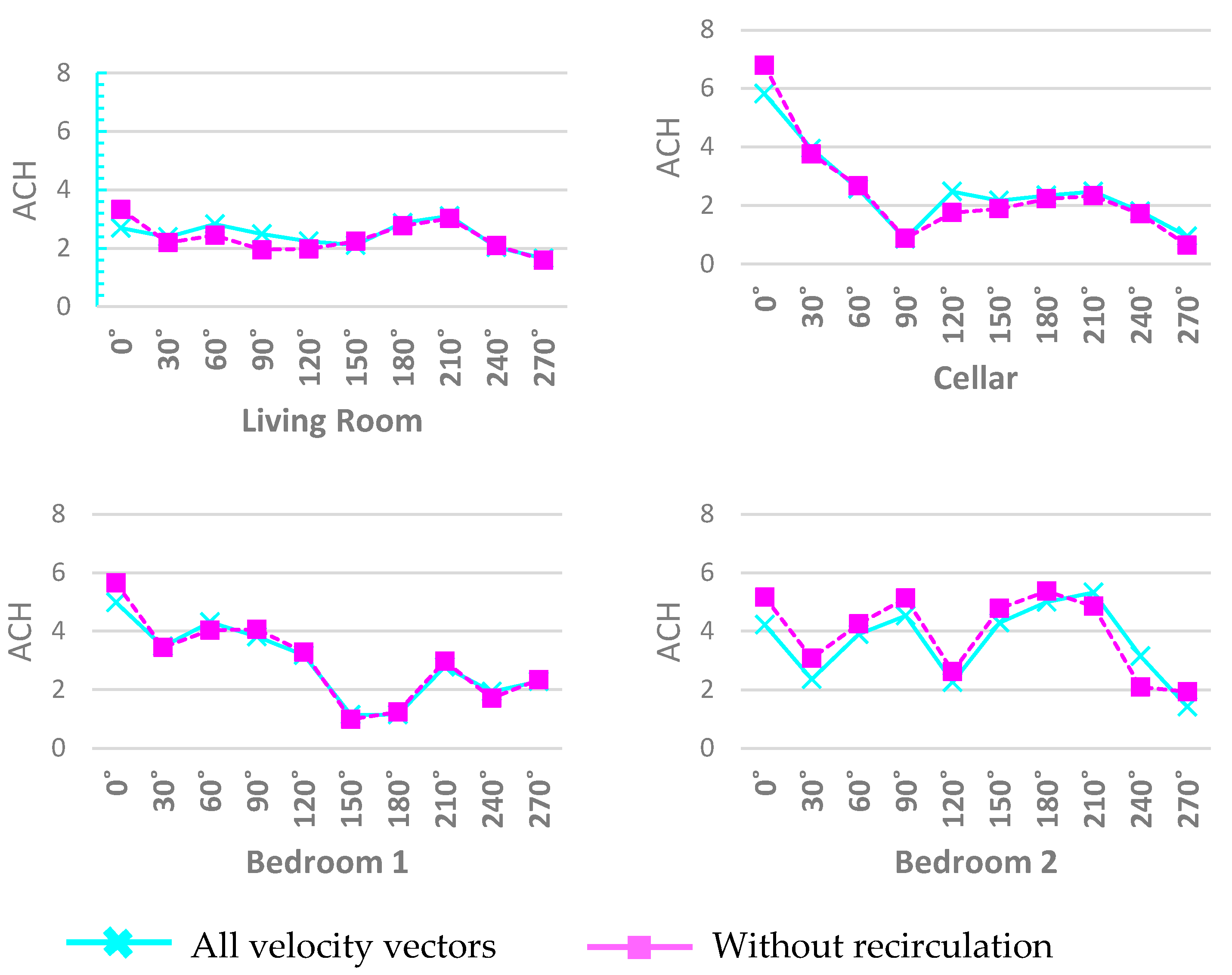
| Room Vol (m³) | Opening-Type Width × Height (m) | Area of Openings (m²) |
|---|---|---|
| Living Room 65.7 | L_S (ext. doors) 2.2 × 2.1-2 L_H_N (int. door) 1.2 × 2.1 L_C_N (int. door) 0.9 × 2.1 L_E (window) 0.8 × 1.15 L_W (window/ext. door) 0.8 × 1.15/1 × 2.10 | 17.6 |
| Cellar 29.6 | C_N (window) 0.8 × 1.15 L_C_N (int. door) 0.9 × 2.1 | 2.81 |
| Bedroom 1 33.7 | R1_W (ext. door) 1 × 2.10 R1_E (int. door) 0.9 × 2.1 | 3.02 |
| Bedroom 2 25.9 | R2_S (ext. door) 1.4 × 2.1 R2_N (int. door) 0.9 × 2.1 | 4.83 |
| Bedroom 3 24.6 | R3_S (ext. door) 1.4 × 2.1 R3_N (int. door) 0.9 × 2.1 | 4.83 |
| Mesh Type | Refine Levels | Cells Count | Mean Scalar Velocity (1st Floor) | Residuals | ||||
|---|---|---|---|---|---|---|---|---|
| Ux | Uy | Uz | p | Cumulative Continuity | ||||
| 1. Coarse | 2,3 | 758,617 | 0.174975 | 4.1 × 10−5 | 2.5 × 10−7 | 4.1 × 10−5 | 3.3 × 10−3 | 1.068 × 10−8 |
| 2. Medium | 3,4 | 1,225,845 | 0.1726165 | 3.6 × 10−5 | 3.0 × 10−7 | 2.9 × 10−5 | 3.8 × 10−3 | 1.061 × 10−8 |
| 3. Fine | 4,5 | 3,880,640 | 0.171156 | 3.5 × 10−5 | 2.6 × 10−7 | 3.6 × 10−5 | 3.8 × 10−3 | 1.325 × 10−8 |
Publisher’s Note: MDPI stays neutral with regard to jurisdictional claims in published maps and institutional affiliations. |
© 2021 by the authors. Licensee MDPI, Basel, Switzerland. This article is an open access article distributed under the terms and conditions of the Creative Commons Attribution (CC BY) license (https://creativecommons.org/licenses/by/4.0/).
Share and Cite
Rodrigues Marques Sakiyama, N.; Frick, J.; Bejat, T.; Garrecht, H. Using CFD to Evaluate Natural Ventilation through a 3D Parametric Modeling Approach. Energies 2021, 14, 2197. https://doi.org/10.3390/en14082197
Rodrigues Marques Sakiyama N, Frick J, Bejat T, Garrecht H. Using CFD to Evaluate Natural Ventilation through a 3D Parametric Modeling Approach. Energies. 2021; 14(8):2197. https://doi.org/10.3390/en14082197
Chicago/Turabian StyleRodrigues Marques Sakiyama, Nayara, Jurgen Frick, Timea Bejat, and Harald Garrecht. 2021. "Using CFD to Evaluate Natural Ventilation through a 3D Parametric Modeling Approach" Energies 14, no. 8: 2197. https://doi.org/10.3390/en14082197
APA StyleRodrigues Marques Sakiyama, N., Frick, J., Bejat, T., & Garrecht, H. (2021). Using CFD to Evaluate Natural Ventilation through a 3D Parametric Modeling Approach. Energies, 14(8), 2197. https://doi.org/10.3390/en14082197





